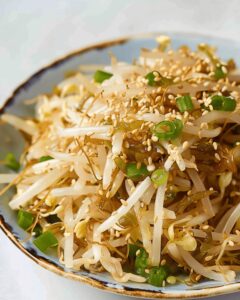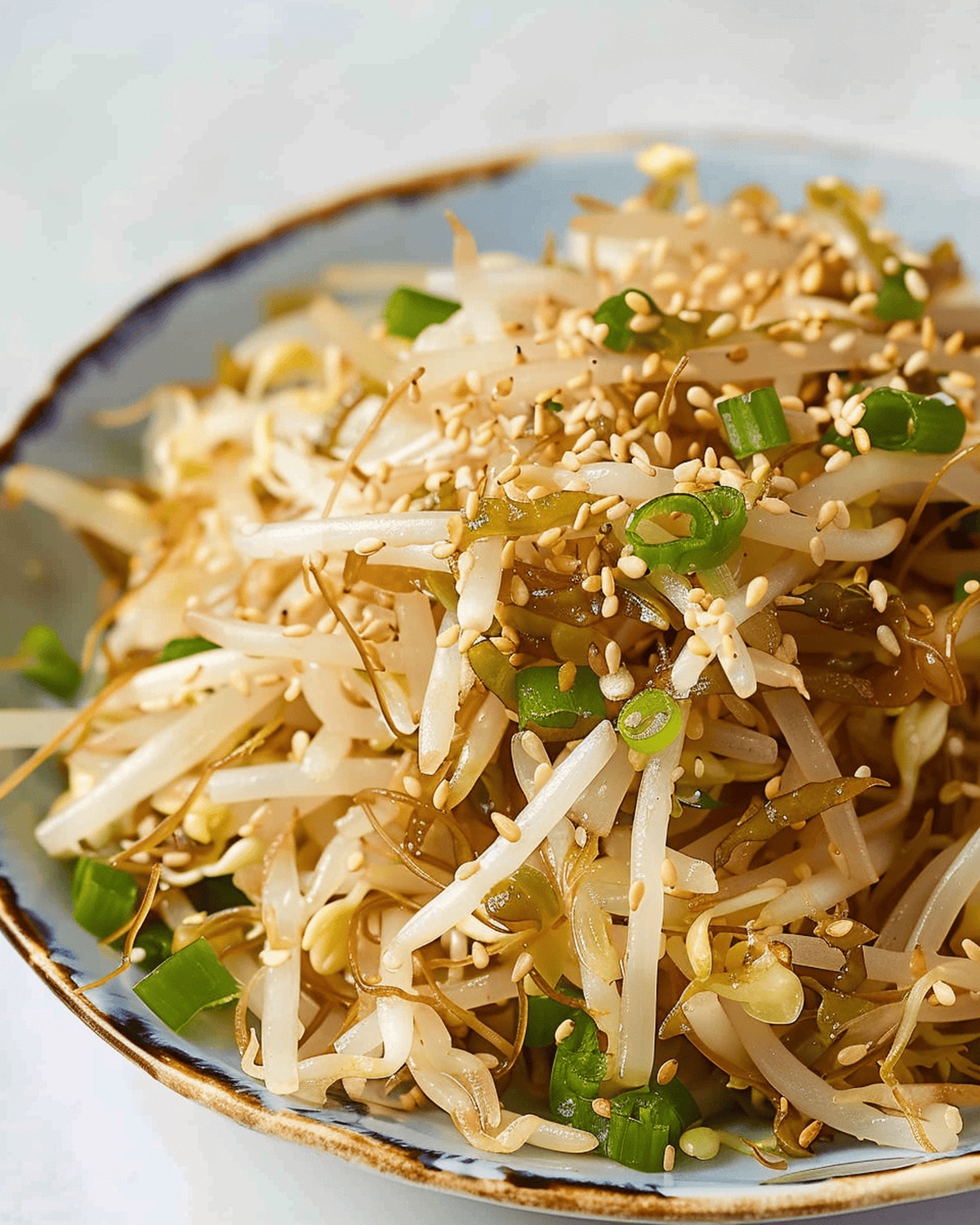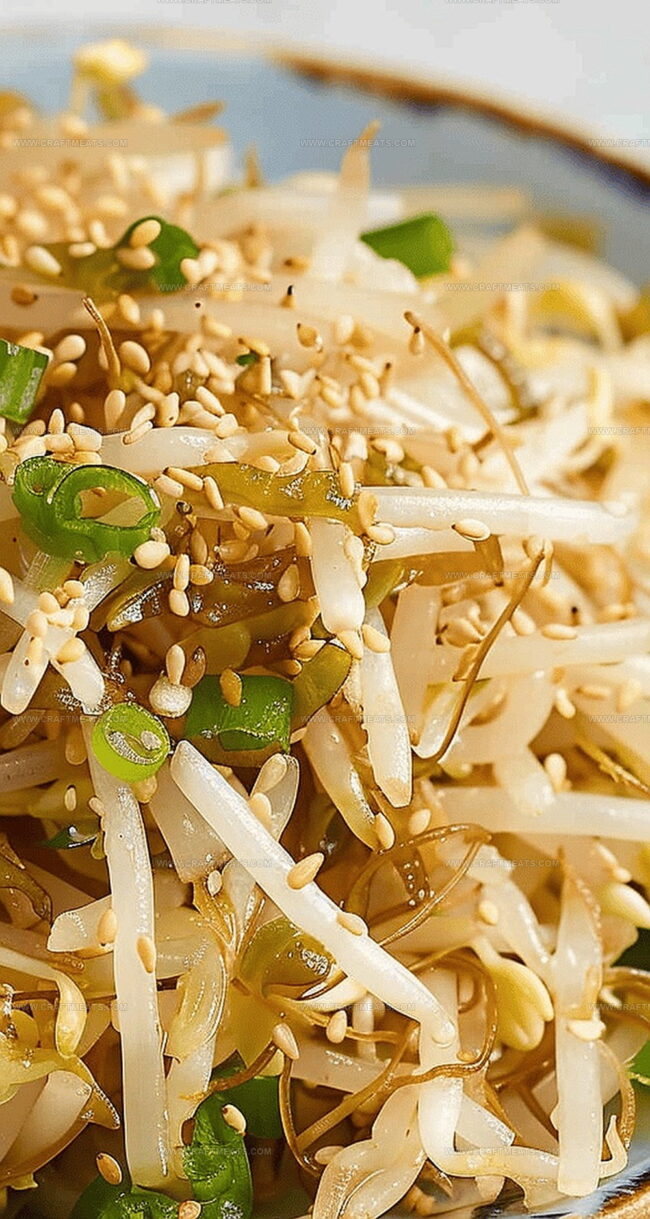Simple 10-Minute Korean Bean Sprout Salad Recipe (Sukju Namul)
Korean bean sprout salad brings a crisp, refreshing crunch to any meal with its vibrant, light character.
These delicate sprouts redefine simple ingredients into a delightful side dish bursting with subtle flavors.
Mild yet distinctive, the salad offers a unique texture that dances between tender and snappy.
Ancient culinary traditions shine through this minimalist preparation, highlighting the beauty of fresh, quality ingredients.
Seasoned cooks and kitchen novices alike can master this quick recipe with ease.
The magic lies in its simplicity, allowing each component to shine brilliantly.
You’ll love how quickly this dish comes together, creating a memorable accompaniment to your favorite meals.
Why 10-Minute Easy Korean Bean Sprout Salad (Sukju Namul) Is the Ultimate Side
Ingredients for Quick Korean Bean Sprout Salad
Main Ingredients:
Bean Sprouts:- Mung Bean Sprouts, Soy Bean Sprouts: Fresh and crisp sprouts that form the base of this light and refreshing Korean salad, with a delicate crunch and mild flavor.
Seasoning Ingredients:
Sauce Components:- Soy Sauce, Toasted Sesame Oil: Classic Korean seasoning that provides a rich, savory umami depth and nutty undertone to the salad.
Aromatics:- Garlic, Green Onion: Fresh herbs that add a sharp, pungent flavor and aromatic complexity to the dish.
Finishing Touches:- Toasted Sesame Seeds, Salt: Provides a subtle nutty crunch and enhances the overall seasoning of the salad.
How to Make Sukju Namul in Just 10 Minutes
Step 1: Wash Bean Sprouts
Rinse bean sprouts in a colander under cold water multiple times. Keep washing until water becomes crystal clear and all dirt is removed. Gently shake to remove excess moisture.
Step 2: Blanch Sprouts Quickly
Boil water in a large pot over high heat. Drop bean sprouts into boiling water and cook for exactly 60 seconds. This quick blanching process softens sprouts while maintaining their crisp texture.
Step 3: Cool Down Sprouts
Immediately transfer blanched sprouts to cold running water. Continuously rinse until sprouts reach room temperature. Drain completely using a strainer, removing all water droplets.
Step 4: Create Flavor Sauce
In a mixing bowl, combine sauce ingredients:Whisk ingredients until perfectly blended and aromatic.
Step 5: Combine and Serve
Add cooled bean sprouts to sauce bowl. Gently toss until every sprout is evenly coated. Transfer to serving dish and enjoy as a refreshing Korean side dish.
Tips for Keeping Korean Bean Sprout Salad Crisp and Flavorful
Best Way to Store and Reheat Korean Bean Sprout Salad
What to Serve with Sukju Namul for a Full Meal
Ways to Add Flair to Korean Bean Sprout Salad
Print
10-Minute Easy Korean Bean Sprout Salad (Sukju Namul) Recipe
- Total Time: 6 minutes
- Yield: 4 1x
Description
Korean bean sprout salad dances with crisp freshness and zesty sesame notes. Quick and simple, this traditional banchan delivers authentic Korean flavor that delights your palate with minimal effort.
Ingredients
Main Ingredients:
- 1 lb (454 grams) mung bean sprouts or soy bean sprouts
Seasoning Ingredients:
- 4 teaspoons (20 milliliters) regular soy sauce
- 4 teaspoons (20 milliliters) toasted sesame oil
- 1 teaspoon toasted sesame seeds
- ½ teaspoon salt
Aromatic Ingredients:
- 2 cloves garlic, minced
- 1 green onion, finely chopped
Instructions
- Meticulously cleanse the bean sprouts under cold running water, agitating them gently to eliminate any residual impurities. Repeat the rinsing process multiple times until the water becomes crystal clear, then thoroughly drain the sprouts.
- Fill a spacious pot with water and ignite the heat to its maximum setting. Once the water reaches a vigorous boil, carefully submerge the bean sprouts and allow them to blanch for approximately 45-60 seconds, ensuring they remain crisp and vibrant.
- Immediately transfer the blanched sprouts to a colander and cascade cold water over them, rapidly cooling the vegetables and halting the cooking process. Gently shake the colander to remove excess moisture, creating a perfectly dry texture.
- Craft a harmonious sauce by whisking together the soy sauce, toasted sesame oil, crushed sesame seeds, finely minced garlic, delicately chopped green onions, and a pinch of salt in a generous mixing bowl. Blend the ingredients until they create a cohesive, aromatic mixture.
- Introduce the impeccably drained bean sprouts into the sauce, using gentle folding motions to ensure each sprout becomes luxuriously coated with the flavorful dressing. Distribute the seasonings evenly, creating a uniform and tantalizing side dish.
- Refrigerate briefly to enhance the flavors, then serve chilled as a refreshing and zesty accompaniment to your meal. The sprouts should glisten with a light, fragrant coating that promises a delightful culinary experience.
Notes
- Quick, refreshing Korean side dish bursting with crisp texture and savory sesame flavors.
- Minimal ingredients transform simple bean sprouts into a restaurant-quality banchan in just minutes.
- Traditional recipe offers lightweight, nutritious accompaniment perfect for balancing heavier Korean main courses.
- Prep Time: 5 minutes
- Cook Time: 1 minute
- Category: Lunch, Appetizer, Snacks
- Method: Boiling
- Cuisine: Korean
Nutrition
- Serving Size: 4
- Calories: 80
- Sugar: 1g
- Sodium: 400mg
- Fat: 5g
- Saturated Fat: 1g
- Unsaturated Fat: 4g
- Trans Fat: 0g
- Carbohydrates: 7g
- Fiber: 2g
- Protein: 4g
- Cholesterol: 0mg




Isabella Rossi
Founder & Culinary Content Creator
Expertise
Recipe Development, Traditional Irish and European Cuisines, Food Styling and Photography, Culinary Education
Education
Dublin Institute of Technology (DIT) – School of Culinary Arts and Food Technology
Ballymaloe Cookery School
Liam is the voice behind many of Craft Meats’ most flavorful features. With roots in Dublin’s smoky barbecue scene and a culinary degree from the Dublin Institute of Technology, he brings time-tested cooking techniques to life.
His training at Ballymaloe Cookery School sharpened his farm-to-table approach, giving him a deep respect for every ingredient he writes about.
He’s not about overcomplicating the process, just helping you cook meat that’s worth talking about. When he’s not writing or grilling, he’s out foraging or nerding out on regional spice blends to add to his next recipe.